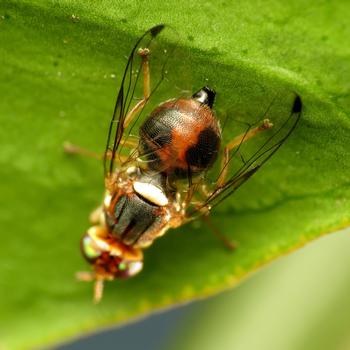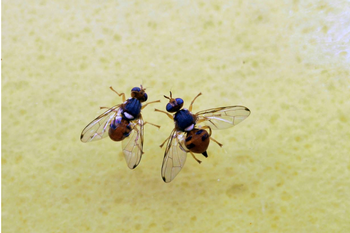Strategies to manage the olive fruit fly
-
Martha Proctor
-
California’s Central Valley and Central Coast produce 99% of the olives grown in the US. The olive fruit fly, Bactrocera oleae, first discovered in California in the Los Angeles area in 1998, is a serious insect pest of olive crops worldwide. Interestingly, the olive fruit fly is in the same insect family as the Mediterranean fruit fly which caused havoc to California’s fruit crops in 1989.
 The olive fruit fly may produce up to six generations a year and wreak havoc on the fruit crops of olive trees. Photo: Flicker.com
The olive fruit fly may produce up to six generations a year and wreak havoc on the fruit crops of olive trees. Photo: Flicker.comDamage to the fruit ensues after the female fly deposits eggs inside developing olives. The eggs hatch in two to three days and the larvae begin feeding on the olive flesh. Micro-organisms invade the fruit at the site of the deposit inducing pulp destruction and rot. Affected olives develop ripe fruit flavors while the fruit is still green, but ultimately dry out and fall from the trees. In warm areas, the olive fruit fly may produce up to five or six generations each year.
Sanitation is a vital step in preventing outbreaks. To avoid adding to the olive fly population, remove any old fruit remaining on the tree or on the soil after harvest as these olives often contain eggs or larvae.
Surveying fruit for infestation both on the tree and on fruit that has fallen from the tree can give some indication of the severity of an infestation or the chances of one developing. Adult fruit flies can be monitored using McPhail, Olipe or yellow sticky traps. Although traps reduce damage, they are best used as monitoring devices as they can’t compete with the attractiveness of the fruit once it ripens.
Place traps in fruiting trees by March 1 in warmer locations. Hang the traps mid-canopy, in the shade and in an open area so leaves don’t block the trap. Record the number of flies trapped weekly. The number of flies caught will decrease in the hot summer and increase as the weather cools. The male olive fruit fly is pictured on the left and female olive fruit fly is on the right. Photo: Andrew John Jessup/IAEA
The male olive fruit fly is pictured on the left and female olive fruit fly is on the right. Photo: Andrew John Jessup/IAEAMcPhail traps are plastic or glass with a reservoir to which a liquid bait is added. Flies enter from the bottom of the trap and drown in the solution. The yellow McPhail trap gives better results than the other colors. Use 3 to 4 torula yeast tablets per trap to catch flies; change monthly. Adding a pheromone does not increase trap catches. In hot weather, add water to the trap to replace water that has evaporated. To count trapped flies, empty the trap contents into a sieve so flies can be separated out.
Alternatively, yellow sticky traps baited with a pheromone lure or ammonium bicarbonate may be used. Careful sanitation and the use of GF-120 Naturalyte Fruit Fly Bait (spinosad), sprays of kaolin clay, and mass trapping are acceptable for use in an organically certified crop. Also, helpful to know is that olive fruit fly adults feed on honeydew so reducing black scale populations may reduce that as a food source.
Applications of bait sprays like GF-120 Naturalyte are very effective and should begin when trap captures begin to increase in early summer. If flies are captured in spring and there is a history of damage, begin spinosad bait treatments when fruit are approximately 3/8 of an inch long. It is at this point that flies begin to sting fruit and larvae develop. Once initiated, continue to apply bait sprays according to label directions to protect the crop until harvest. If fly captures begin to increase in late summer but few fly stings on fruit are found, continue treatments with spinosad, kaolin clay, or both.
Recent reports indicate much higher success rates using kaolin clay than any of the baits. Apply kaolin clay in early June or for more effectiveness, later in the season when most of the damage to fruit occurs. Completely coat leaves and fruit. After the spray dries, it turns into a white powdery coat, which acts as a repellant to olive flies. The clay will need to be rinsed from the fruit before processing.


